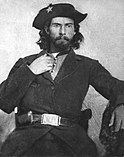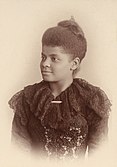From today's featured articleWilliam Anderson (1840 – October 26, 1864), known as "Bloody Bill" Anderson, was one of the deadliest pro- Confederate guerrilla leaders of the American Civil War, leading a band of volunteer partisans who targeted Union loyalists and federal soldiers in Missouri and Kansas. After his father was killed by a Union loyalist judge during the war, Anderson killed the judge and fled to Missouri where he robbed travelers and killed several Union soldiers. In 1863 he took a leading role in the Lawrence massacre and later participated in the Battle of Baxter Springs. By 1864 Anderson was the leader of a group of raiders in Missouri. In September 1864, he led a raid on the town of Centralia, where his men captured a passenger train; they executed 24 unarmed Union soldiers in the Centralia Massacre. Later that day they killed more than a hundred Union militiamen in an ambush. Anderson died in battle a month later. ( Full article...)
Recently featured:
Did you know ...
|
In the news
On this day
More anniversaries:
|
From today's featured list
As of 2020, there are seven World Heritage Sites in Finland. The United Nations Educational, Scientific and Cultural Organization (UNESCO) World Heritage Sites are places of importance to cultural or natural heritage as described in the UNESCO World Heritage Convention, established in 1972. Finland accepted the convention on 4 March 1987, making its historical sites eligible for inclusion on the list. The first two sites added to the list were Old Rauma and the Fortress of Suomenlinna (pictured), both in 1991, at the 15th Session of the World Heritage Committee. Six of Finland's sites are classified as cultural sites according to the UNESCO criteria, while one, the High Coast / Kvarken Archipelago, is a natural site. This is a transnational site and is shared with Sweden. In addition to its World Heritage Sites, Finland also maintains six properties on its tentative list. ( Full list...)
Today's featured picture

|
|
Naqsh-e Rostam is an ancient Persian necropolis located about 12 km (7.5 mi) northwest of Persepolis in Iran. The site includes rock reliefs from the Achaemenid and Sassanid periods, and four tombs of Achaemenid kings. The oldest relief, dating from around 1000 BC, is thought to be Elamite in origin. The tombs carved into the rock, as seen from left to right in this panoramic photograph, are thought to belong to Darius II (423–404 BC), Artaxerxes I (465–424 BC), Darius I (522–486 BC), and Xerxes I (486–465 BC), respectively. An inscription on the facade of Darius I's tomb mentions his conquests and achievements. In the far left of the image is the Cube of Zoroaster, belonging to the Achaemenid era (5th century BC); its purpose is unclear. Inscriptions on its walls in three languages have been described as the "most important historical documents from the Sassanian era". Photograph credit: Diego Delso
Recently featured:
|
Other areas of Wikipedia
- Community portal – Bulletin board, projects, resources and activities covering a wide range of Wikipedia areas.
- Help desk – Ask questions about using Wikipedia.
- Local embassy – For Wikipedia-related communication in languages other than English.
- Reference desk – Serving as virtual librarians, Wikipedia volunteers tackle your questions on a wide range of subjects.
- Site news – Announcements, updates, articles and press releases on Wikipedia and the Wikimedia Foundation.
- Village pump – For discussions about Wikipedia itself, including areas for technical issues and policies.
Wikipedia's sister projects
Wikipedia is hosted by the Wikimedia Foundation, a non-profit organization that also hosts a range of other projects:
Free media repository
Wiki software development
Wikimedia project coordination
Free textbooks and manuals
Free knowledge base
Free-content news
Collection of quotations
Free-content library
Directory of species
Free learning resources
Free travel guide
Dictionary and thesaurus




